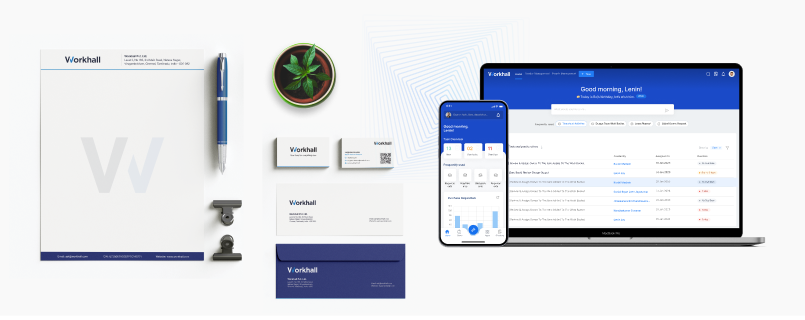
Design system at workhall
Welcome to the Workhall Design System, your go-to resource for crafting cohesive and compelling product experiences. Designed to maintain consistency across platforms, our system offers a unified approach to branding, visual elements, and user interface components.
Why do we need a design system?
A design system serves as a guiding light, ensuring everyone speaks the same design language. It acts as a central hub for visual elements, UI patterns, and guidelines. This consistency not only fosters a harmonious look but also accelerates design and development processes.
As our company expands, navigating through the complexities of product design without a design system is akin to a maze. With our design system, the path is clear, scaling effortlessly to introduce new products and features while maintaining a consistent user experience
Updates and improvements become seamless, with a single change rippling across the organization. Users benefit from a system that prioritizes user-friendliness and accessibility, creating an intuitive bridge between our products and users
This also helps the team when new team members join, they're not overwhelmed by a mishmash of design choices. Instead, they're welcomed by a comprehensive guide that helps them hit the ground running. It's like handing them a treasure map that leads to design success. The best part? A design system isn't static. It evolves with us, adapting to new technologies, trends, and user preferences.
Our Goals
1. Flawless customer experience
2. Simplify complex designs
3. Futuristic scalability
4. Dynamic team collaboration
5. Uniform Design Consistency
What is an atomic design system?
Atomic design is a methodology for creating design systems that emphasizes the creation and organization of design components at a modular level. It was introduced by Brad Frost and is used to streamline and scale the design and development process by breaking down interfaces into smaller, reusable parts.
The term "atomic" refers to the analogy with the atomic elements in chemistry, where atoms are the building blocks of matter. Similarly, in atomic design, components are the fundamental building blocks of an interface. These components are organized into a hierarchy based on their complexity and how they combine to form larger elements.
The five levels of the atomic design methodology are:
1. Atoms: The Fundamental Building Blocks
Atoms are the elemental particles of a design system. They encompass the simplest UI elements, such as buttons, input fields, icons, and typography. These atomic components are the foundation upon which the entire design system is constructed. Individually, atoms might appear mundane, but collectively, they form the basis for more complex UI elements.
2. Molecules: Functional Combinations
Molecules arise from the fusion of atoms. They represent groups of atoms working together harmoniously to fulfill specific functions. Examples of molecules include search bars, which amalgamate an input field atom, a search button atom, and perhaps a text label atom. Molecules serve as the functional units that facilitate user interactions.
3. Organisms: Complex Components with Purpose
Organisms are higher-level components that combine molecules and atoms to create more intricate UI sections. These components, such as navigation bars, headers, and product cards, encapsulate meaningful sections of the user interface. Organisms contribute to both modularity and consistency, enabling designers and developers to efficiently manage and update complex structures.
4. Templates: Blueprinting Layouts
Templates define the layout and arrangement of organisms and molecules within a given screen or page. They serve as blueprints, guiding the placement of different components while maintaining consistency across various pages. Templates provide a systematic framework for designers to create consistent and visually appealing designs.
5. Pages: Realisation of the Design System
Pages are the tangible manifestations of the design system. They combine templates, organisms, molecules, and atoms to create fully realised user interfaces with real content. Pages showcase how the design system comes to life in actual user interactions, representing the culmination of the Atomic Design process.
Utilizing an atomic design system
An Atomic Design System serves as a robust foundation for designing and developing digital products across various contexts, including:
1. No-Code Platforms:
For no-code platforms, an Atomic Design System empowers users with limited technical skills to create and customise design elements. It offers a structured framework to maintain design consistency while simplifying the process of interface creation.
2. Web and Mobile Applications:
In the realm of web and mobile apps, an Atomic Design System ensures that design elements remain consistent and visually appealing across different screens and devices. It expedites the design and development process by providing a library of pre-designed components.
3. Branding and Marketing:
The design system becomes a repository for brand elements like colours, typography, and logos, ensuring brand consistency across marketing materials and digital touch-points.
4. Collaborative Design and Development:
An Atomic Design System fosters collaboration between designers and developers. Designers create components while developers implement them, streamlining communication and enhancing efficiency.
Advantages for Designers and Developers:
1. Designers:
- Maintain Consistency: Establish a unified visual language throughout the design.
- Increase Efficiency: Quickly create mockups and prototypes using reusable components.
- Foster Modularity: Develop and update individual components while preserving overall consistency.
- Ensure Scalability: Easily expand the system as projects evolve and grow.
2. Developers:
- Enhance Efficiency: Leverage documented design components to accelerate development.
- Enable Interoperability: Facilitate seamless collaboration between design and development teams.
- Simplify Maintenance: Modify and update components without disrupting the broader design system.
- Implement Responsive Design: Utilise guidelines for responsive layouts to ensure adaptability across devices.
An Atomic Design System serves as a structured methodology for creating cohesive and consistent user interfaces. This approach empowers designers and developers to collaborate effectively, streamline their workflow, and produce high-quality, user-centric digital experiences.